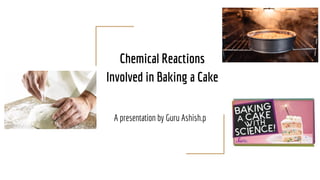
Chemical reactions involved in baking a cake
- 1. Chemical Reactions Involved in Baking a Cake A presentation by Guru Ashish.p
- 2. Most baking is based on the use of flour, the powder form of grains, nuts and beans. Wheat flour, the most commonly used type of flour in baking, is composed largely of starch and protein, with very high levels of a class of protein known collectively as gluten. When water is added to wheat flour, the gluten forms a heavy, pliable mass. This expands greatly under hot temperatures and sets with the desired airy texture.
- 3. Leavening Agents Leavening agents such as baking soda, baking powder and yeast give baked dough its lightness. Baking soda reacts with acids in the dough to make carbon dioxide, which helps the dough to rise. Baking powder, which is baking soda with an additional acidic salt, releases carbon dioxide twice during the baking process, once when it hits water, and again when it reaches a certain temperature in the oven. Heat helps baking powder produce tiny bubbles of carbon dioxide, which make a cake light and fluffy. When yeast, a single-celled fungus that feeds on starch and sugars, is added to dough, it also releases carbon dioxide bubbles, giving the dough a light, delicate texture.
- 4. Browning Reactions Sugar does much more than just sweeten a cake. When the baking temperature reaches 300 degrees Fahrenheit, sugar undergoes what is known as a Maillard reaction, a chemical reaction between amino acids, proteins and reducing sugars. The result is browning, which forms the crust of many baked goods, such as bread. The Maillard reaction is not the same as caramelization, but both work together to create appetizing golden-brown surfaces and an array of flavors. Sugar also provides a direct food source for yeast, enhancing the yeast's activity.
- 5. Emulsification and Binding Eggs in a cake mixture may fulfill one or more of three functions. Beaten egg white is used, like baking powder, to give the dough a light, fluffy consistency. This is possible because egg white (albumen) contains lecithin, a protein that coats the air bubbles created during beating, which stops the cake from sinking during baking. ILecithin also acts as a binder to hold the cake together. When egg is used as a glaze, it also acts as a source of protein for the sugar's Maillard reaction.
- 6. Protein Bonding Flour contains two important proteins -- glutenin and gliadin. When water is added to flour to make dough, it allows these proteins to bond together and from a new protein called gluten. Kneading the dough intensifies these gluten bonds. After the dough is place into a heated oven, it begins to rise and grow the gluten network. This network eventually hardens during the baking process, giving the inside of a loaf of bread or similar baked good its signature structure.
- 7. Magic Leaveners Leavening agents -- such as yeast, baking powder and baking soda -- give baked dough its pillowy lightness. Baking soda achieves this by reacting with acids in the dough to produce carbon dioxide gas, which puffs up the dough. Baking powder releases carbon dioxide twice during the entire baking process -- once when it hits water and once when it reaches a certain temperature in the oven. When yeast is added to dough, it begins to feed on starches -- producing sugars, alcohol and carbon dioxide as byproducts. As with baking powder and baking soda, the carbon dioxide produced by yeast causes the dough to rise
- 8. Maillard Reactions Maillard reactions occur when proteins and sugars are broken down and rearranged by high temperatures. These sugars and proteins can be derived from flour by itself, or they can be enhanced with the addition of sugars and eggs. The reactions produce ring-shaped organic compounds that darken the surface of baking dough. Maillard reactions also produce toasty and savory aromas and flavor compounds. These compounds also react among each other, producing even more complex aromas and flavors.
- 9. Flavors of Caramelization Caramelization, which occurs at 356 degrees Fahrenheit, is the last chemical reaction to occur during the baking process. The reaction occurs when high heat causes sugar molecules to break down and release water, which turns into steam. Diacetyl, which gives caramel its butterscotch flavor, is produced during the first stages of caramelization. Next, esters and lactones, which have a rum-like flavor, are produced. Finally, the production of furan molecules imparts a nutty flavor, and a molecule called maltol imparts a toasty flavor.